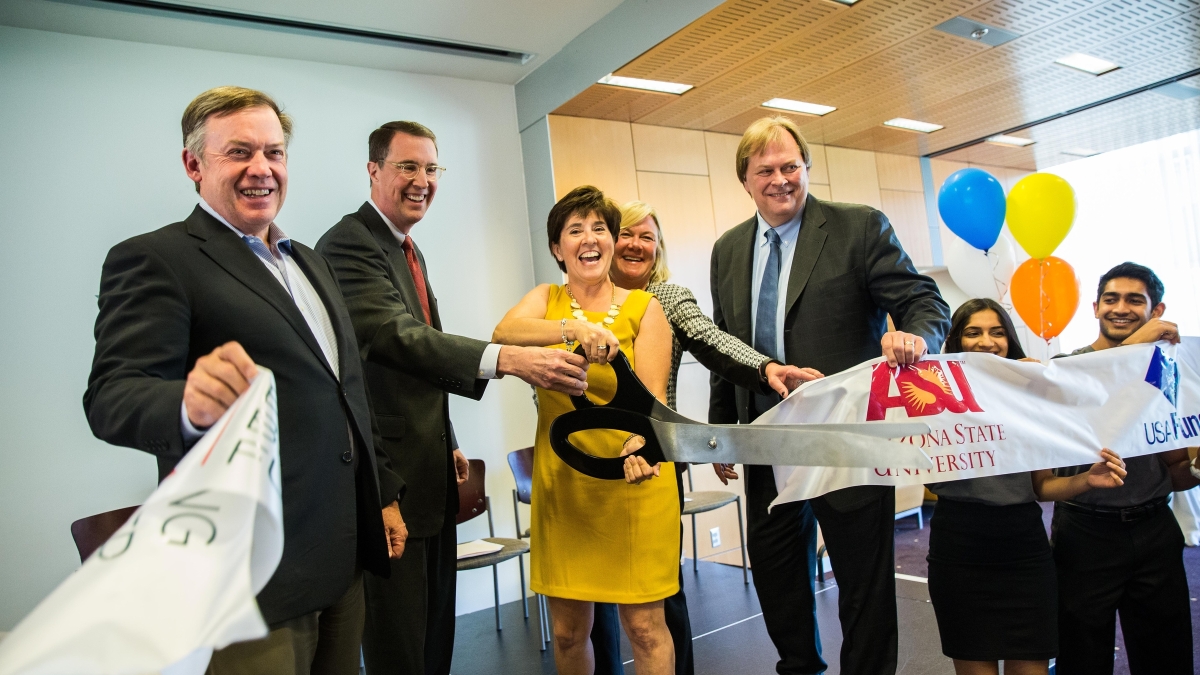Editor's note: This story is being highlighted in ASU Now's year in review. To read more top stories from 2016, click here.
Arizona State University is partnering with a nonprofit organization and PayPal in a program that will provide students jobs as well as tuition assistance based on their grades.
Education at Work expects to hire 400 ASU students this year for on-campus jobs with PayPal, and the students will be eligible to receive up to $6,000 a year in tuition assistance on top of hourly pay.
The partnership will help students avoid debt and develop “soft skills” that are needed for professional careers, as well as provide enthusiastic workers to PayPal, which operates a worldwide online payment system.
University President Michael M. Crow said that ASU’s mission of inclusiveness means that there is a broad spectrum of socioeconomic backgrounds among students on campus — and 60 percent of them work at least 20 hours a week.
“It’s a way for us to continue our path of breaking down barriers and making things happen,” he said Monday at a ceremony in Tempe celebrating the new partnership. “We’re hoping we can grow this to 1,000 students and we become a prototype for other universities and that other companies step up.
“What we need is for people to stop complaining about the way things are and start working on how to solve these problems.
“We need to find every possible solution wherein a student can overcome whatever their financial barrier might be. And in addition to that, figure out what work is. This is work that is in the marketplace, dealing with customers, dealing with interaction, working in real-time issues outside the university.”
“It’s a way for us to continue our path of breaking down barriers and making things happen. ... What we need is for people to stop complaining about the way things are and start working on how to solve these problems.”
— ASU President Michael M. Crow
Education at Work is a nonprofit organization that helps reduce college-student debt by partnering with companies that hire the students. It was launched in 2012 in Cincinnati and already partners with the University of Cincinnati, Xavier University, Mount St. Joseph University and Northern Kentucky University. As of March, the organization’s student employees have earned $1,752,572 in tuition assistance and $9,801,724 in wages.
Students can have any major and typically work 12 to 20 hours a week. Education at Work says that most jobs start at $9 per hour, and students can get a $50 bonus for signing up a friend.
To receive the tax-free tuition assistance, students must be employed at least two months. The assistance amount is based on grade-point average and maxes out at $6,000 per year. Full-time students who have a GPA of 2.5 to under 3.0 would earn $1,000 per semester, while those whose grades are 3.0 to under 3.5 get $1,500 and those with 3.5 or above get $3,000. The money is paid to the university, which applies the funds to tuition.
Some of the 400 students have already been hired. Sanya Virani, a biology and psychology major at ASU who will be a sophomore in the fall, said she’s excited to work for the Education at Work job because the hours are flexible, it’s on campus and she’ll be working with other students. She said she’s not daunted by the thought of dealing with customers on the phone.
“They give you six weeks of interactive training to deal with different situations, so they teach you everything you need to know and that will be really valuable in the future,” she said.
Michelle Lim, who will be a junior in the fall, said she was interested because her nursing program has higher costs.
“There’s the textbooks, program fees, scrubs and things like that. I had never seen an opportunity where they pay you to work and also give you tuition assistance,” she said.
Karen Marshall, vice president of global operations for PayPal North America, said the company expects good productivity from the students.
“We expect customer-satisfaction scores will be higher than we’ve seen in other centers, and that’s what we pride ourselves on,” she said.
“We also hope to build a talented pipeline of individuals who would aspire to come to work in PayPal, in our contact center but also technology, human resources, finance, you name it.”
Apply for a job here.
Top photo: (From left) ASU President Michael M. Crow, Education at Work Chief Financial Officer Steve Rolls, Education Works Vice President of Customer Care at Sharon Maestas, PayPal North America Vice President of Global Operations Karen Marshall and USA Funds CEO Bill Hansen participate in a ribbon-cutting during a ceremony celebrating the new partnership Monday afternoon at the Memorial Union in Tempe. Photo by Deanna Dent/ASU Now
More University news

Year in review: ASU's top stories for 2024
As the year draws to a close, ASU News is revisiting some of the university's biggest stories in 2024 — from big announcements to rare books to the Beatles. So pour a warm cuppa and peruse our…

ASU earns 'Gold' in inaugural Times Higher Education Online Learning Ranking
Arizona State University continues to set the standard in online learning, having earned a Gold rating in the inaugural Times Higher Education Online Learning Ranking 2024. This recognition…
2024 President's Awards honor ASU projects for real-world impact
Ten Arizona State University programs were honored for their real-world solutions during the annual President’s Awards ceremony held on Dec. 6.The awards formally recognize successful solutions in…
